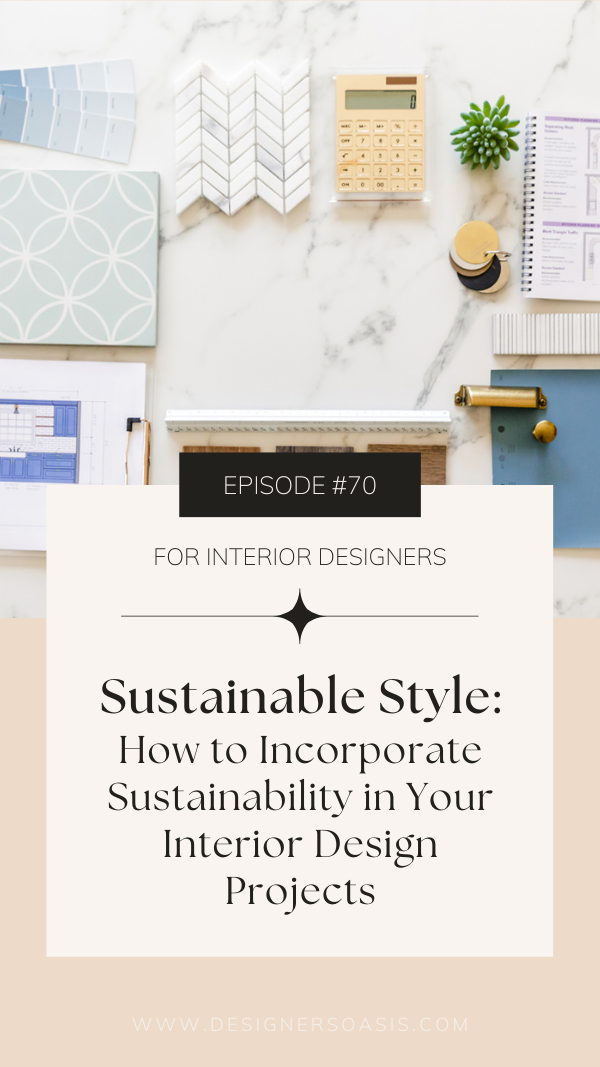# 70 | Sustainable Style: How to Incorporate Sustainability in Your Interior Design Projects
“You don’t have to sacrifice your margins or profit to embrace sustainability.”
Spotify | Apple Podcast | Audible | I Heart Radio | Google Podcast | Youtube
In this episode, we dive deep into crucial aspects of interior design, focusing on pricing strategies, time management, and the imperative shift toward sustainability. I advocate for responsible design leadership and share my journey toward a more sustainable approach.
Here are the highlights from the episode.
The Environmental Impact of Fast Furnishings
Waste - Nearly 10M tons of furnishings went go to the landfill. (Source)
Greenhouse Gasses - A recently published report suggested that an average piece of furniture generates up to 47kg of carbon dioxide equivalents or the same amount as burning 5.3 gallons of gasoline. (Source)
Industrial-scale Deforestation - The majority of fast furniture is manufactured in China. By 1990, China had depleted its own forests, prompting the country to import wood from Russia, Africa, and the United States for furniture production. Subsequently, the finished furniture is sent back to these countries, with a primary focus on the United States.
Child Labor and Unfair Labor Practices - This is especially problematic in the rug and textile manufacturing industries. Child labor affects 160 million children worldwide, these children have the highest illiteracy rates in the world. (source)
Key Principles of Sustainable Interior Design
#1 Specify Eco-Friendly Materials
Textiles use a ton of energy, water, and heavy metals to produce. Not to mention the agricultural effects of fertilizers and pesticides used on industrial crops. Specify organic cotton or linen when appropriate. Look for textiles with recycled content. Cork and wool are renewable products.
#2 Reduce the Use of Raw Materials
Sourcing vintage, antique, and architectural salvage is a great option. Also, consider re-upholstering high-quality furniture.
BTW - YES you can and should markup vintage & antique items. Put it in your contract!
#3 Source High-Quality Goods
It's our responsibility to educate ourselves and our clients on how furniture is made. Understand things like suspension systems, framing, joinery, and the quality of fabric selections.
“You get what you pay for” is an adage that rings true for furnishings. While quality may be a greater investment when you educate your clients on the differences and remind them that you are their partner to make smart choices they can feel good about, those extra costs start to make sense and are no longer an objection.
#4 Improve Indoor Air Quality
Furnishings and finishes emit toxic chemicals into the air after they are installed, a process called “off-gassing”. While you can’t avoid it entirely, you can minimize it by opting for more natural products. Volatile Organic Compounds or VOCs should be minimized. Look for no or low VOC paints and adhesives, natural rugs made of wool or natural fibers such as jute, avoiding vinyl whenever possible, and look for products that are GreenGuard or FloorScore certified.
#5 Reduce Water Use
“Hidden Water” refers to the millions of gallons of water that go into manufacturing consumer goods in just about everything we touch.
A typical cotton bedsheet uses more than 2,500 gallons of water to make.
Anytime we can reduce the demand for new consumer goods, you are saving 1000’s of gallons of water.
Water-efficient plumbing fixtures should be the standard for all plumbing specifications. Look for fixtures that have the Water Sense label.
#6 Source Ethically / Social Responsibility
Look for manufacturers committed to fair labor practices, environmentally friendly materials, and ethical production processes.
Avoid mass-produced art. There is an endless opportunity to support emerging artists that allow you to find unique and one-of-a-kind pieces of art affordably.
Benefits of Sustainable Style
When you effectively communicate the value of sustainability to your clients, you are making a major impact on the health of the planet and people.
You don’t have to sacrifice your margins or profit to embrace sustainability. They not only can co-exist but embracing sustainability as a core value in your business can help align you with like-minded clients. Making smarter choices IS good business.
Resources mentioned in this episode:
FREE DOWNLOAD: 7 Habits of Highly Profitable Interior Designers
LEARN: On-Demand Masterclasses
Sign up for The Brief today!
If this episode has helped you, please consider rating and reviewing the podcast. (Five Stars is awesome!)
This helps me continue to make episodes for you.
★★★★★
Rate & Review
OTHER WAYS TO ENJOY THIS EPISODE:
✍️ READ THE TRANSCRIPT




